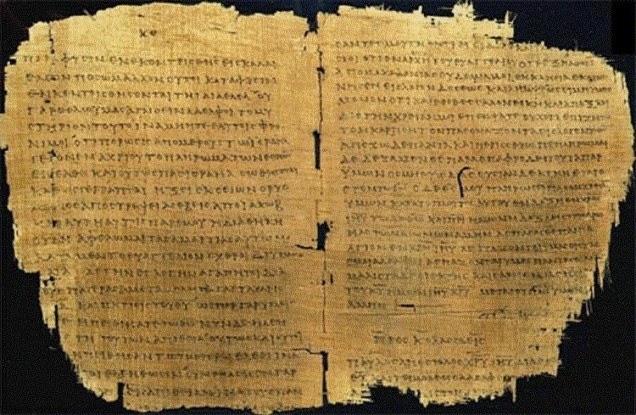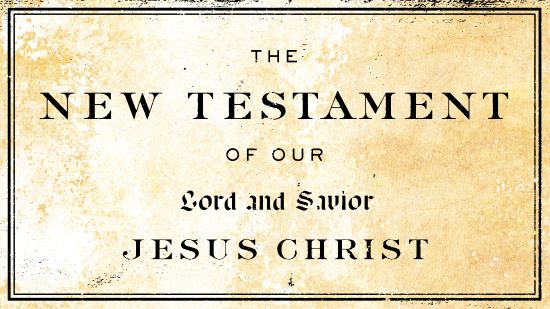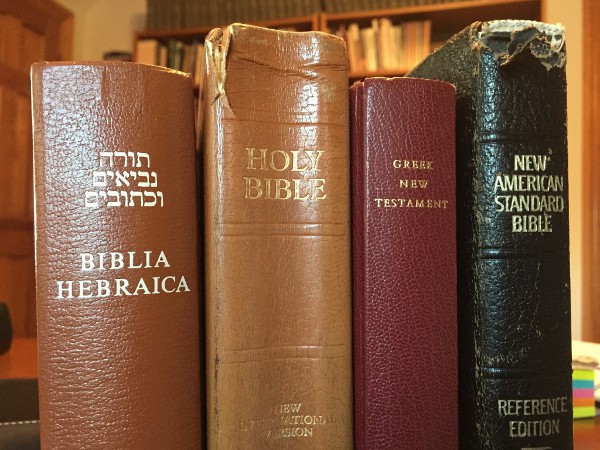Tekstualna kritika i Biblija

U našem znanstvenom i obrazovanom dobu, preispitujemo mnoga neznanstvena uvjerenja koja su imale ranije generacije. Taj skepticizam posebno vrijedi za Bibliju. Mnogi od nas preispituju pouzdanost Biblije na temelju onoga što znamo o njoj. Uostalom, Biblija je napisana prije više od dvije tisuće godina. Ali veći dio tih tisućljeća nije bilo tiskare, fotokopirnih strojeva ili izdavačkih kuća. Stoga su se izvorni rukopisi prepisivali ručno, generacija za generacijom. Istodobno su jezici izumirali, a nastajali novi, carstva su se mijenjala, a nove sile su se uzdizale.
Budući da su izvorni rukopisi odavno izgubljeni, kako znamo da je ono što danas čitamo u Bibliji ono što su izvorni autori zapravo napisali? Možda je Biblija promijenjena ili iskrivljena. Možda su to učinili crkveni vođe, svećenici, biskupi ili redovnici jer su željeli promijeniti njezinu poruku za svoje potrebe.
Principi tekstualne kritike
Naravno, ovo pitanje vrijedi za svaki drevni spis. Tekstualna kritika je akademska disciplina koja utvrđuje je li se drevni tekst promijenio od svog izvornog sastava do danas. Budući da je to akademska disciplina, primjenjuje se na svaki drevni spis s bilo kojeg jezika. Ovaj članak objašnjava neke osnovne principe tekstualne kritike i primjenjuje ih na Bibliju kako bi se utvrdila njezina pouzdanost.
Ovaj dijagram prikazuje primjer hipotetskog dokumenta napisanog 500. godine prije Krista. Izvorni tekst nije dugo trajao. Stoga, prije nego što propadne, bude izgubljen ili uništen, mora se napraviti rukopisna (MSS) kopija (1. primjerak). Prepisivanje je obavljala profesionalna skupina ljudi nazvana pisari . Kako godine prolaze, pisari izrađuju kopije (2. i 3. primjerak) 1. primjerka. U nekom trenutku, primjerak se sačuva tako da postoji i danas (3. primjerak).

Načelo 1: Vremenski intervali rukopisa
U našem primjeru dijagrama, pisari su izradili ovaj postojeći primjerak 500. godine nove ere. To znači da najraniji podatak o stanju teksta koji možemo znati je tek nakon 500. godine nove ere. Stoga vrijeme od 500. pr. Kr. do 500. godine nove ere (označeno s x na dijagramu) čini razdoblje tekstualne nesigurnosti. Iako je original napisan mnogo prije, svi rukopisi prije 500. godine nove ere su nestali. Stoga ne možemo procijeniti primjerke iz tog razdoblja.
Dakle, prvo načelo koje se koristi u tekstualnoj kritici jest mjerenje ovog vremenskog intervala. Što je ovaj interval x kraći , to više povjerenja možemo imati u ispravno očuvanje dokumenta do našeg vremena, budući da se smanjuje razdoblje nesigurnosti.
Načelo 2: Broj postojećih rukopisa
Drugi princip koji se koristi u tekstualnoj kritici jest brojanje broja postojećih rukopisa danas. Naš gornji primjer pokazao je da je dostupan samo jedan rukopis (treći primjerak). Ali obično danas postoji više od jednog primjerka rukopisa. Što više rukopisa postoji danas, to su podaci o rukopisu bolji. Povjesničari tada mogu usporediti primjerke s drugim primjercima kako bi vidjeli razlikuju li se i koliko se ti primjerci međusobno razlikuju. Dakle, broj dostupnih primjeraka rukopisa postaje drugi pokazatelj koji određuje tekstualnu pouzdanost drevnih spisa.
Tekstualna kritika klasičnih grčko-rimskih spisa u usporedbi s Novim zavjetom
Ovi principi primjenjuju se na sve drevne spise. Stoga usporedimo sada rukopise Novog zavjeta s drugim drevnim rukopisima koje znanstvenici prihvaćaju kao pouzdane. Ova tablica navodi neke poznate…
| Autor | Kada je napisano | Najraniji primjerak | Vremenski raspon | # |
| Cezar | 50. pr. Kr. | 900. godine poslije Krista | 950 | 10 |
| Platon | 350. pr. Kr. | 900. godine poslije Krista | 1250 | 7 |
| Aristotel* | 300. pr. Kr. | 1100. godine poslije Krista | 1400 | 5 |
| Tukidid | 400. pr. Kr. | 900. godine poslije Krista | 1300 | 8 |
| Herodot | 400. pr. Kr. | 900. godine poslije Krista | 1300 | 8 |
| Sofoklo | 400. pr. Kr. | 1000. godine poslije Krista | 1400 | 100 |
| Tacit | 100. godine poslije Krista | 1100. godine poslije Krista | 1000 | 20 |
| Plinije | 100. godine poslije Krista | 850. godine poslije Krista | 750 | 7 |
Rukopisni podaci poznatih drevnih pisaca prihvaćeni kao pouzdani
McDowell, J. Dokazi koji zahtijevaju presudu . 1979. str. 42-48
*iz bilo kojeg djela
Ovi pisci predstavljaju glavne klasične pisce antike. U osnovi, njihovi su spisi oblikovali razvoj europske i zapadne civilizacije. No, u prosjeku su nam preneseni samo u 10-100 rukopisa. Štoviše, najraniji postojeći primjerci sačuvani su otprilike 1000 godina nakon što je original napisan. Tretiramo ih kao naš kontrolni eksperiment jer čine spise koji čine temelj povijesti i filozofije. Stoga ih akademici i sveučilišta diljem svijeta prihvaćaju, koriste i podučavaju.
Rukopisi Novog zavjeta
Sljedeća tablica uspoređuje rukopise Novog zavjeta prema istim principima tekstualne kritike. Zatim ćemo to usporediti s našim kontrolnim podacima, baš kao i u svakom znanstvenom istraživanju.
| MSS | Kada je napisano | Datum MSS-a | Vremenski raspon |
| John Rylan | 90. godine nove ere | 130. godine nove ere | 40 godina |
| Bodmerov papirus | 90. godine nove ere | 150.-200. godine nove ere | 110 godina |
| Chester Beatty | 50.-60. godine nove ere | 200. godine nove ere | 20 godina |
| Vatikanski kodeks | 50.-90. godine nove ere | 325. godine nove ere | 265 godina |
| Sinajski kodeks | 50.-90. godine nove ere | 350. godine nove ere | 290 godina |
Tekstualni podaci najranijih rukopisa Novog zavjeta
Comfort, PW Podrijetlo Biblije , 1992. str. 193

Međutim, ova tablica daje samo kratak pregled nekih od postojećih rukopisa Novog zavjeta. Broj rukopisa Novog zavjeta toliko je velik da bi ih bilo nemoguće nabrojati u jednoj tablici.
Svjedočanstvo o stipendiji
Kao što kaže jedan znanstvenik koji je godinama proučavao ovo pitanje:
„Danas imamo više od 24 000 rukopisnih primjeraka dijelova Novog zavjeta… Nijedan drugi dokument iz antike ne može se ni približiti takvom broju i potvrdi. U usporedbi s tim, Homerova ILIJADA je druga sa 643 rukopisa koji su još uvijek sačuvani.“
McDowell, J.Dokazi koji zahtijevaju presudu. 1979. str. 40
Vodeći znanstvenik Britanskog muzeja potvrđuje ovo:
„Znanstvenici su zadovoljni što posjeduju u velikoj mjeri istinite tekstove glavnih grčkih i rimskih pisaca … no naše znanje o njihovim spisima ovisi o tek nekolicini rukopisa, dok se rukopisi Novog zavjeta broje u … tisućama“
Kenyon, FG (bivši ravnatelj Britanskog muzeja)Naša Biblija i drevni rukopisi. 1941., str. 23.
Ovi se podaci odnose posebno na rukopise Novog zavjeta. Ovaj članak bavi se tekstualnom kritikom Starog zavjeta.
Tekstualna kritika Novog zavjeta i Konstantin
Značajno je da je velik broj ovih rukopisa izuzetno star. Na primjer, razmotrite uvod knjige koja prepisuje najranije grčke dokumente Novog zavjeta.
„Ova knjiga pruža transkripcije 69 najranijih rukopisa Novog zavjeta… datiranih od početka 2.stoljećado početka 4.stoljeća(100.-300. godine)… koji sadrže oko 2/3 teksta Novog zavjeta“
Comfort, PW „Tekst najranijih grčkih rukopisa Novog zavjeta“. str. 17. 2001.
Ovo je značajno jer ovi rukopisi potječu iz razdoblja prije rimskog cara Konstantina (oko 325. godine). Također prethode usponu Katoličke crkve na vlast. Neki se pitaju je li Konstantin ili Katolička crkva izmijenio biblijski tekst. To možemo provjeriti usporedbom rukopisa iz razdoblja prije Konstantina (325. godine) s onima koji dolaze kasnije. Međutim, nalazimo da se nisu promijenili. Rukopisi iz, recimo, 200. godine iste su kao i oni koji dolaze kasnije.
Dakle, ni Katolička crkva ni Konstantin nisu mijenjali Bibliju. Ovo nije vjerska izjava, već se temelji isključivo na podacima iz rukopisa. Donja slika prikazuje vremensku liniju rukopisa iz kojih potječe današnji Novi zavjet.

https://www.youtube.com/embed/903plFVy1eY?feature=oembed&enablejsapi=1&origin=https://hrvatski.good-path.com Sveučilišna prezentacija o tekstualnoj kritici Novog zavjeta
Implikacije biblijske tekstualne kritike
Što možemo zaključiti iz ovoga? Svakako, barem u onome što objektivno možemo izmjeriti, Novi zavjet je provjeren u mnogo većoj mjeri nego bilo koje drugo klasično djelo. Presuda se najbolje može sažeti sljedećim:
„Biti skeptičan prema rezultirajućem tekstu Novog zavjeta znači dopustiti da sva klasična antika padne u zaborav, jer nijedan drugi dokument iz antičkog razdoblja nije tako dobro bibliografski potvrđen kao Novi zavjet.“
Montgomery,Povijest i kršćanstvo. 1971. str. 29

Ono što on misli jest da ako sumnjamo u pouzdanost očuvanosti Biblije, trebali bismo odbaciti sve što znamo o klasičnoj povijesti. Pa ipak, nijedan upućeni povjesničar to nikada nije učinio. Znamo da se biblijski tekstovi nisu mijenjali kako su ere, jezici i carstva dolazili i odlazili. To znamo jer najraniji postojeći rukopisi prethode tim događajima. Na primjer, znamo da nijedan pretjerano revni srednjovjekovni redovnik ili papa koji je kovao zavjeru nije dodao Isusova čuda u Bibliju. Imamo rukopise koji dolaze prije svih srednjovjekovnih redovnika i papa. Budući da svi ovi rani rukopisi sadrže Isusova čuda, onda ih ovi izmišljeni srednjovjekovni zavjerenici nisu mogli umetnuti.
Što je s prijevodom Biblije?
Ali što je s pogreškama u prijevodu? Zašto danas postoji toliko različitih verzija Biblije? Znači li postojanje mnogih verzija da je nemoguće utvrditi što su izvorni autori napisali?

Prvo, razjasnimo jednu uobičajenu zabludu. Mnogi misle da je Biblija danas prošla kroz dugi niz koraka prevođenja. Zamišljaju svaki novi jezik preveden s prethodnog. Stoga vizualiziraju niz otprilike ovako: grčki -> latinski -> srednjovjekovni engleski -> Shakespeareov engleski -> moderni engleski -> drugi moderni jezici.
Lingvisti danas prevode Bibliju na različite jezike izravno s izvornih jezika. Tako se za Novi zavjet prijevod nastavlja s grčkog na moderni jezik. Za Stari zavjet prijevod se nastavlja s hebrejskog na moderni jezik ( više detalja, uključujući pravoslavne prijevode, ovdje ). Ali osnovni grčki i hebrejski tekst je standardan. Dakle, različite verzije Biblije proizlaze iz načina na koji su ih lingvisti odabrali prevesti na moderni jezik.
Pouzdanost prijevoda
Zbog opsežne klasične literature napisane na grčkom (izvornom jeziku Novog zavjeta), moguće je precizno prevesti izvorne misli i riječi izvornih autora. Zapravo, različite moderne verzije to potvrđuju. Na primjer, pročitajte ovaj poznati stih u najčešćim verzijama i primijetite malu varijaciju u riječima, ali dosljednost u ideji i značenju:
23 Jer, plaća za grijeh je smrt, a dar što ga Bog daje jest vječni život po Isusu Kristu, našem Gospodinu.
Rimljanima 6:23 (suvremeni hrvatski prijevod)
23 Jer plaća za grijeh je smrt, a Božji je dar vječni život u našemu Gospodinu Isusu Kristu.
Rimljanima 6:23 (Knijga O Kristu)
23 Jer je plaća grijeha smrt, a Božji je dar milosti život vječni u Kristu Isusu, Gospodinu našemu.
Rimljanima 6:23 (Hrvatski Novi Zavjet – Rijeka 2001)
Možete vidjeti da nema neslaganja između prijevoda jer govore potpuno istu stvar koristeći samo malo drugačije riječi.
Zaključak
Ukratko, ni vrijeme ni prijevod nisu iskvarili ideje i misli izražene u izvornim biblijskim rukopisima. Te ideje nam danas nisu skrivene. Znamo da Biblija danas točno prenosi ono što su njezini autori zapravo napisali u to vrijeme.
Ali važno je shvatiti što ova studija ne pokazuje. To ne dokazuje nužno da je Biblija Božja riječ.
https://www.youtube.com/embed/4vh16uNhnCc?feature=oembed&enablejsapi=1&origin=https://hrvatski.good-path.com Tekstualna kritika Starog zavjeta
No razumijevanje tekstualne pouzdanosti Biblije pruža nam početnu točku s koje možemo započeti istraživanje Biblije. Možemo vidjeti možemo li odgovoriti i na ova druga pitanja . Također se možemo informirati o njezinoj poruci . Budući da Biblija tvrdi da je njezina poruka Božji blagoslov za vas, što ako je moguće da je istinita? Možda vrijedi odvojiti vrijeme kako bismo saznali neke od važnih događaja iz Biblije. Dobro je započeti na njezinom početku.